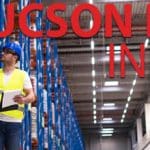Tucson’s industrial market, owing to strong demand from tenants and owner users due to logistics and warehouse space constraints, has outpaced construction. As a result, the vacancy rate has decreased and stabilized at 2.5%.
The increased reliance on online ordering and the need for last-mile delivery has increased due to the pandemic creating a demand for the industrial market. In contrast, the supply disruptions chain and reduced consumer discretionary spending have affected some manufacturers. Since the pandemic, most of the leased space has been smaller than 10,000 SF, but a growing proportion of larger tenants are growing if they can find or wait for the new construction to be finished in the third quarter of 2023.
The growing tenant base over the last few years bodes well for the market’s long-term prospects. Amazon, when it was built, it aided the region’s advancement as a logistics center with an 857,000 sq ft distribution center at the Port of Tucson. In addition, it has occupied another 269,500 sq feet in various parts of Tucson.
Although it is not the primary driver of industrial demand, advanced manufacturing activity is rising. Sion Power Corporation, based in Tucson, is a battery developer for electric vehicles and military drones. It recently signed two leases totaling more than 212,000 SF to expand its manufacturing operations. The expansion will be finished by 2026 and generate over 150 high-quality jobs. Over the next five years, an estimated $341 million in economic impact is expected.
American Battery Factory revealed plans for a 2 million square foot facility at the Aerospace Research Campus to manufacture lithium iron phosphate (LFP) battery cells. It will be the largest gigafactory in the country, bringing in an estimated $1.2 billion in capital investment, $3.1 billion in economic impact for the state, and speeding the development of the clean energy economy to produce lithium iron phosphate (LFP) battery cells,
Leading global medical equipment provider Becton, Dickinson, and Company is moving forward on their plans to spend $65 million in Tucson, Arizona, to build a cutting-edge facility that will serve as a hub for the business’ supply chain and a final-stage manufacturing and sterilizing facility. It is anticipated that the new 120,000-square-foot plant will have over 40 new positions, including engineers, scientists, quality control specialists, and other qualified personnel, which BD will add. According to Sun Corridor, Inc., the investment by BD will boost the local economy by $122 million over the following ten years.
Recently opened Eurofins Donor Testing Services, which offers complete laboratory services to address the transplant community’s distinct testing and processing needs,
E-commerce and logistics companies are drawn to the area due to its proximity to major Mexican and California markets. With the I-10 and I-19 and a Union Pacific intermodal rail line, the Port of Tucson is an ideal location for the distribution and logistics industries.
The SW Tucson/Airport Submarket is quickly becoming the primary market. Tucson’s expanding industrial market. FedEx and UPS HomeGoods have recently constructed new distribution centers.
As a result, the submarket’s inventory has increased. Affordability is a key demand driver in the Tucson market. The industrial market. The average asking rent per square foot is $10.40 is less expensive than the National Index and far less expensive than Rents in California. In terms of rent, the logistics sector outperforms all other sectors. In growth due to high demand, with a 7.3% increase over the past 12 months.
Following a somewhat busy 2021, developers launched construction on a handful of significant industrial projects in 2022. In the previous decade, supply additions have been minimal, and any new building has been restricted to purpose-built projects. Around 2.6 million SF are currently under construction in the Tucson market, which, when completed, will increase the current supply by 5.7%.
Developers are paying a great deal of attention to the region surrounding Tucson International Airport. The Tucson Commerce Center is a speculative industrial park located north of the airport. Situated between Valencia Road and Alvernon Way, the development consists of three 4-Star complexes totaling over 800,000 square feet. In addition, the Campbell Landing industrial project just finished construction on four 10,000-SF buildings with three-phase power and 24-foot eave heights. At the village of Marana, farther north, construction began on a speculative industrial park comprising nearly 1.8 million SQ FT. The five-building complex includes 36-foot clear heights and is adjacent to the freeway.
SALES
In 2021, investment volume reached a new high; however, in 2022, it moderated little. Trailing 12-month sales volume equals $197 million compared to the $232 million that transpired a year prior. Moreover, robust fundamentals and relative cost remain important factor A factor that stimulates investor interest in Tucson. Despite continual price increases, Tucson continues to be cheap compared to the United States and Phoenix. The median of 7.6% is around 150 basis points over the U.S. average. Private investors and owner-occupants dominate, whereas institutional investors and REITs have access to the market.
Historically, they have been spectators. In the preceding twelve months, the more significant part of sales has been for lower-tier properties priced under $1 million. Regarding location, Investors and tenants were especially active in the Northwest. Southwest Tucson Airport, Tucson/Oro Valley, and Park/Ajo submarkets.
Share your experiences on working with Commercial Real Estate Group of Tucson.















